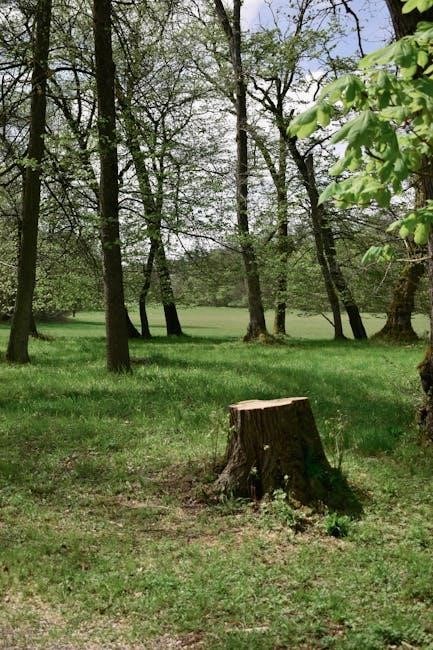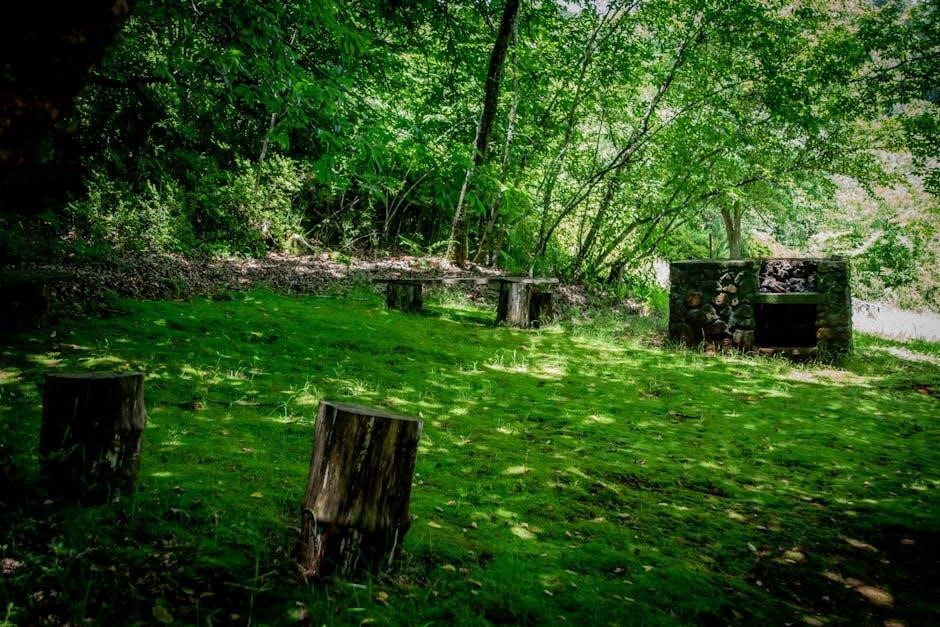
stump shade guide
A stumpery is a unique shade garden concept that creatively repurposes tree stumps and logs, blending them with shade-loving plants to create a tranquil, wildlife-friendly habitat.
Definition and History of Stumpery
A stumpery is a garden style utilizing tree stumps, logs, and woody debris to create a habitat for shade-loving plants like ferns, mosses, and lichen. Originating in 19th-century England, it gained popularity as a unique way to recycle natural materials. The term was first coined by John Claudius Loudon in 1838, describing it as a “new gardenesque feature.” This eco-friendly approach blends nature and artistry, offering a tranquil retreat for both wildlife and gardeners.
Benefits of Creating a Stumpery Garden
Creating a stumpery garden offers numerous benefits, including transforming unwanted tree stumps into a wildlife-friendly habitat. It provides a unique, low-maintenance, eco-friendly way to enhance shaded areas. The combination of woody debris and shade-loving plants creates a tranquil retreat, attracting insects and small animals. This sustainable garden style promotes biodiversity while adding aesthetic charm to otherwise neglected spaces, making it a perfect solution for eco-conscious gardeners seeking creativity and functionality.

Choosing the Right Stumps

Selecting the right stumps is crucial for a successful stumpery garden. Opt for sturdy, weathered tree trunks or large root balls that provide texture and create natural habitats for plants and wildlife.
Types of Tree Stumps Suitable for Shade Gardens
For a stumpery garden, choose sturdy tree stumps with interesting textures, such as oak, beech, or pine. Large root balls and weathered trunks work best, as they provide natural habitats for shade-loving plants. Consider the size and decay stage of the stumps, as older ones can host moss and lichen, adding beauty and biodiversity to your shaded garden space.

How to Prepare and Position Stumps in Your Garden
To prepare stumps, clean them of debris and ensure they are stable in the ground. Position them in shaded areas, either singly or in groups, to create a natural, whimsical display. Arrange stumps at varying heights and angles for visual interest. Surround them with mulch or woodchips to retain moisture and blend seamlessly into the garden. This setup provides a perfect base for shade-loving plants to thrive around and atop the stumps.

Selecting Shade-Loving Plants
Choose ferns, hostas, and caladiums for their vibrant foliage and ability to thrive in shaded areas. These plants add texture and color, complementing the natural beauty of stumps and logs.
Popular Shade Plants for Stumpery Gardens
Ferns, foxgloves, and caladiums are ideal for stumpery gardens, offering vibrant foliage and delicate blooms. Hostas and primroses add texture, while bluebells and lily of the valley provide carpets of color. These plants thrive in shaded environments, complementing the natural beauty of stumps and creating a harmonious, wildlife-friendly space that enhances the garden’s tranquility and visual appeal throughout the growing season.
How to Pair Plants with Stumps for Optimal Growth

Pair shade-loving plants like ferns and mosses directly with stumps, allowing them to grow on or around the woody surfaces. Position plants with similar light and moisture requirements near stumps to create a harmonious ecosystem. Use mulch or woodchip around stumps to retain moisture and suppress weeds, ensuring healthy growth. This natural arrangement enhances the garden’s aesthetic and supports plant thriving in shaded environments.
Designing Your Stumpery Layout
Arrange stumps and logs thoughtfully to create natural beauty, ensuring shade plants thrive. This design enhances the garden’s aesthetic while fostering a tranquil, wildlife-friendly environment.

Arranging Stumps and Logs for Aesthetic Appeal
Arrange stumps and logs to create natural, visually appealing compositions. Mix varying sizes and shapes to add depth and interest. Place larger stumps as focal points, while smaller logs blend seamlessly into the background. Incorporate shade-loving plants like ferns and mosses to soften the woody elements. Use rocks and mulch to enhance texture and create a cohesive, organic design that balances structure with natural growth, fostering a serene and wildlife-friendly environment.
Incorporating Decorative Elements Like Moss and Rocks
Add moss and rocks to enhance the natural beauty of your stumpery garden. Moss thrives in shaded, damp areas, creating a lush carpet around stumps and logs. Rocks add texture and contrast, complementing the organic shapes of the wood. Tuck moss into crevices and arrange rocks thoughtfully to create visual balance. This combination creates a serene, harmonious environment that supports plant growth and attracts wildlife, perfect for a shaded, naturalistic garden setting.

Maintenance Tips
Regular mulching around stumps retains moisture and suppresses weeds. Ensure consistent dampness for moss and ferns, while monitoring for pests like insects and fungal growth.
Care and Maintenance of Stumps and Plants
Regularly water shade-loving plants to maintain consistent soil moisture, but avoid overwatering to prevent root rot. Mulch around stumps and plants to retain moisture and suppress weeds. Prune dead or damaged plant foliage to promote healthy growth. Inspect stumps periodically for signs of decay or pests, treating issues promptly to preserve the structure. Keep the area clear of debris to ensure optimal air circulation and light penetration for plants.
Managing Pests and Diseases in a Shaded Environment
Shaded stumpery gardens are prone to pests like slugs and snails, which thrive in moist environments. Regularly inspect plants and stumps for signs of decay or infestation. Avoid overwatering, as excessive moisture can lead to root rot and fungal diseases. Use organic pest control methods, such as copper barriers or beer traps, to deter slugs. Improve air circulation by spacing plants appropriately and removing debris to reduce humidity. Mulch around stumps to suppress weeds and retain moisture, but avoid piling it against plant stems. Monitor for common shade garden issues like powdery mildew and treat promptly with fungicides if necessary. Keep the area clean and well-maintained to prevent pest and disease buildup.
Incorporating Stumpery into Your Garden
Stumpery enhances shaded areas by transforming tree stumps into decorative features. It complements water gardens, woodland paths, or secluded retreats, creating a wildlife-friendly, harmonious space that blends nature and design.
Integrating Stumpery with Other Garden Features
Stumperies seamlessly blend with water gardens, pathways, and seating areas, creating a natural, serene atmosphere. Logs and stumps can serve as borders or decorative accents, while shade-loving plants thrive nearby. This integration enhances biodiversity and visual appeal, making stumperies a versatile addition to any garden design, whether as a focal point or a complementary feature.
Creating a Cohesive Shade Garden Design
A stumpery achieves harmony by balancing natural elements like stumps, logs, and shade-loving plants. Layer plants with varying textures and heights to add depth. Incorporate mosses and ferns to soften the wood, while rocks and mulch enhance the natural aesthetic. This design creates a serene, wildlife-friendly space that feels effortlessly integrated into its surroundings, perfect for a peaceful retreat.
Advanced Stumpery Techniques
Explore vertical gardening by stacking stumps or logs to create multi-level planters for shade plants. Experiment with artistic arrangements and upcycling ideas to transform stumps into unique features.
Using Vertical Space with Stumps and Plants
Maximize space in your stumpery by incorporating vertical elements. Stack stumps or logs to create multi-tiered planters for shade plants like ferns or mosses. This technique not only adds visual interest but also provides additional habitats for plants to thrive. Consider adding climbing plants or vines to further enhance the aesthetic appeal and functionality of your vertical stumpery design.
Innovative Ideas for Upcycling Tree Stumps
Transform tree stumps into unique garden features by upcycling them creatively. Hollow out stumps to create natural planters for shade-loving plants like ferns or mosses. Use stumps as bases for vertical gardens, where climbing plants can thrive. Carve or shape stumps into decorative sculptures or seating. Incorporate moss and lichen to add texture and color, blending the stumps seamlessly into your stumpery design while supporting local wildlife and enhancing biodiversity.
Case Studies and Inspiration
Explore real-life examples of thriving stumpery gardens, showcasing creative stump arrangements and plant pairings. Discover how gardeners worldwide transform shaded areas into serene, wildlife-friendly oases using natural materials.
Real-Life Examples of Successful Stumpery Gardens
Many gardeners have transformed shaded areas into stunning stumperies. For instance, a Mississippi gardener created a serene oasis using tree stumps and shade-loving plants like ferns and hostas. Another example is a lower quarry garden where small stumps and mosses were used to craft a tranquil space. These examples highlight how stumperies can attract wildlife and create relaxing habitats, proving their versatility and beauty in shaded environments.
Expert Tips and Tricks for Stumpery Success
Experts recommend selecting sturdy tree stumps and arranging them artistically to create a natural vibe. Incorporate shade-loving plants like ferns and hostas for vibrant color. Add mulch or woodchip around stumps to retain moisture and suppress weeds. Consider vertical arrangements for visual interest. Consulting local Master Gardeners can also provide tailored advice for your climate and soil conditions, ensuring long-term success and beauty in your stumpery garden.

Resources and Community
Explore books, websites, and forums dedicated to stumpery gardening for inspiration. Join local gardening groups and workshops to connect with enthusiasts and learn expert techniques firsthand.
Books, Websites, and Forums for Stumpery Enthusiasts
Discover books on shade gardening and stumpery design for inspiration. Explore websites like Garden Design and Fine Gardening for tutorials. Join forums such as GardenWeb or Reddit’s gardening communities to share ideas and learn from experts. These resources offer invaluable tips and connect you with fellow stumpery enthusiasts worldwide, fostering creativity and knowledge sharing in this unique gardening niche.
Joining Local Gardening Groups and Workshops
Engaging with local gardening groups and workshops connects you with stumpery enthusiasts and experts. These communities offer hands-on experience, tips on native shade plants, and advice on stump preparation. Workshops often cover sustainable gardening practices and creative upcycling ideas. Sharing knowledge and gaining insights from experienced gardeners fosters growth and inspiration, helping you refine your stumpery design and maintenance skills within a supportive environment.